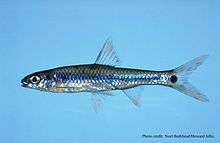Taillight shiner
| Taillight shiner | |
|---|---|
 | |
| Scientific classification | |
| Kingdom: | Animalia |
| Phylum: | Chordata |
| Class: | Actinopterygii |
| Order: | Cypriniformes |
| Family: | Cyprinidae |
| Genus: | Notropis |
| Species: | N. maculatus |
| Binomial name | |
| Notropis maculatus (O. P. Hay, 1881) | |
The taillight shiner (Notropis maculatus) is a species of freshwater fish in the cyprinid family. It is commonly found in the south-eastern USA.
Distribution and habitat
The taillight shiner is found in the lower Mississippi River basin, parts of Cape Fear River in North Carolina, Sabine River in Texas, and throughout Florida, with the exception of the southern tip. Their habitat consists of shallow, slow moving pools, rivers, lakes or swamps, usually containing some aquatic plant life. They have been classified as least concern by the IUCN due to their wide distribution and large populations.[1]
Appearance and behaviour
The taillight shiner has a long thin body and a rounded snout.[2] Adult fish are typically 2-2.5 inches long. They have pale yellow colouring on their back, silvery white colouring on their belly and silvery stripes on their sides. They have a black spot at the base of their tail fin. During breeding season, the males have blackish colouring on the fins, and are suffused with pink or red on body, head and fins.[3]
It is a schooling species that feeds on crustaceans, insects and algae. It completes its entire life cycle in one year. Spawning begins in March, extends into early October and occurs near logs or similar objects. They prefer to spawn in water temperatures of 23–32oC (73–90oF). They reach maturity in 6–9 months, depending of the water temperature at the time of spawning. The female will typically lay between 72–408 eggs.[4] They have been observed to occasionally practice oral grasping behaviour in order to maintain stationary in flowing water.[2]
References
- 1 2 "Notropis maculatus". IUCN Red List of Threatened Species. Version 2013.2. 2013. Retrieved 14 February 2014.
- 1 2 Adams, S. R., et al. (2003). Oral grasping: A distinctive behavior of cyprinids for maintaining station in flowing water. Copeia 2003(4), 851–857.
- ↑ Taillight Shiner, Missouri Department of Conservation
- ↑ Cowell, B. C. and B. S. Barnett. (1974). Life history of the taillight shiner, Notropis maculatus, in central Florida. American Midland Naturalist 91(2), 282–93.
External links
Further reading
- Gotelli, N. J. and M. Pyron. (1991). Life history variation in North American freshwater minnows: effects of latitude and phylogeny. Oikos 62(1), 30–40.
- McAllister, C. T., et al. (2012). Distributional records for four fishes from the Arkansas, Mississippi, and White Rivers of Arkansas. The Southwestern Naturalist 57(2), 217–19.
- Bruce C. Cowell and Brian S. Barnett, American Midland Naturalist, Vol. 91, No. 2 (Apr., 1974), pp. 282–293
- Sandra J. Clarka, John R. Jacksona & Steve E. Lochmannb, pages 676–680
